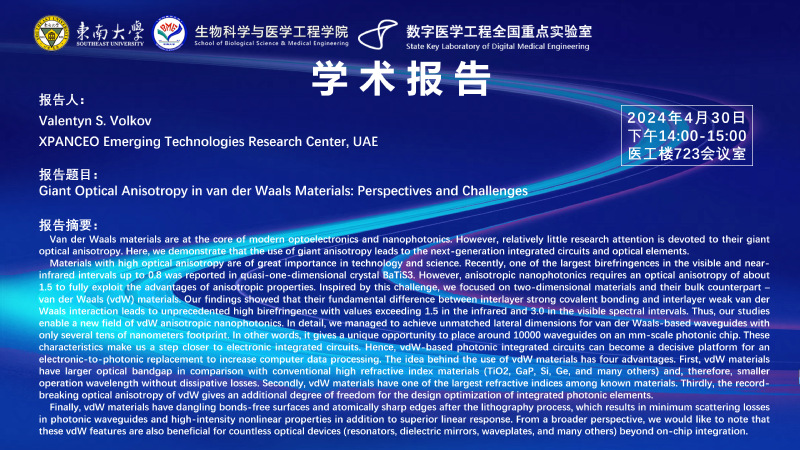报告人:
Valentyn S. Volkov
XPANCEO Emerging Technologies Research Center, UAE
Valentyn S. Volkov received a M.Sc. degree in physics in 2000 from Moscow State University (Russia) and obtained his Ph.D. in 2003 from Aalborg University (Denmark). From 2003 to 2008, he was a postdoctoral researcher at the Department of Physics and Nanotechnology, Aalborg University (Denmark). Since 2008, has been an assistant professor and associate professor at the University of Southern Denmark. In 2019, Valentyn S. Volkov became the director of the MIPT Centre for Photonics and 2D Materials (CP2DM) at the Moscow Institute of Physics and Technology (Russia). Alongside his academic career, he is the co-founder and CTO of XPANCEO, a deep-tech company specializing in next-generation optoelectronic devices, and the managing director of the XPANCEO Emerging Technologies Research Center. Valentyn S. Volkov's research interests encompass various areas such as 2D materials and van der Waals heterostructures, quantum materials and applications, bio-sensing technology, linear and nonlinear nanooptics, plasmonics, and scanning near-field optical microscopy. He has an impressive publication record, with over 200 refereed papers and more than 7000 citations to his name.
报告时间:2024年4月30日14:00-15:00
报告地点:医工楼723会议室
报告题目:Giant Optical Anisotropy in van der Waals Materials: Perspectives and Challenges
报告摘要:
Van der Waals materials are at the core of modern optoelectronics and nanophotonics. However, relatively little research attention is devoted to their giant optical anisotropy. Here, we demonstrate that the use of giant anisotropy leads to the next-generation integrated circuits and optical elements.
Materials with high optical anisotropy are of great importance in technology and science. Recently, one of the largest birefringences in the visible and near-infrared intervals up to 0.8 was reported in quasi-one-dimensional crystal BaTiS3. However, anisotropic nanophotonics requires an optical anisotropy of about 1.5 to fully exploit the advantages of anisotropic properties. Inspired by this challenge, we focused on two-dimensional materials and their bulk counterpart – van der Waals (vdW) materials. Our findings showed that their fundamental difference between interlayer strong covalent bonding and interlayer weak van der Waals interaction leads to unprecedented high birefringence with values exceeding 1.5 in the infrared and 3.0 in the visible spectral intervals. Thus, our studies enable a new field of vdW anisotropic nanophotonics. In detail, we managed to achieve unmatched lateral dimensions for van der Waals-based waveguides with only several tens of nanometers footprint. In other words, it gives a unique opportunity to place around 10000 waveguides on an mm-scale photonic chip. These characteristics make us a step closer to electronic integrated circuits. Hence, vdW-based photonic integrated circuits can become a decisive platform for an electronic-to-photonic replacement to increase computer data processing. The idea behind the use of vdW materials has four advantages. First, vdW materials have larger optical bandgap in comparison with conventional high refractive index materials (TiO2, GaP, Si, Ge, and many others) and, therefore, smaller operation wavelength without dissipative losses. Secondly, vdW materials have one of the largest refractive indices among known materials. Thirdly, the record-breaking optical anisotropy of vdW gives an additional degree of freedom for the design optimization of integrated photonic elements.
Finally, vdW materials have dangling bonds-free surfaces and atomically sharp edges after the lithography process, which results in minimum scattering losses in photonic waveguides and high-intensity nonlinear properties in addition to superior linear response. From a broader perspective, we would like to note that these vdW features are also beneficial for countless optical devices (resonators, dielectric mirrors, waveplates, and many others) beyond on-chip integration.





